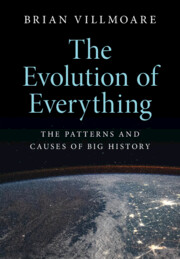Book contents
- The Evolution of Everything
- The Evolution of Everything
- Copyright page
- Contents
- Figure Credits
- Acknowledgments
- Chapter 1: Introduction
- Part I Introduction to the Scientific Perspective on the Past
- Chapter 2: The Origins of the Universe
- Chapter 3: The Structure and History of the Earth
- Chapter 4: Life
- Chapter 5: Evolution
- Chapter 6: Genetics
- Chapter 7: The Evolution of Complex Life
- Chapter 8: The Cambrian Explosion
- Chapter 9: Fish and Land Animals
- Chapter 10: Protohumans
- Chapter 11: The Genus Homo
- Chapter 12: Human Variation
- Chapter 13: Evolution and Human Behavior
- Chapter 14: Brain Evolution
- Chapter 15: Chaos and Complexity
- Part II Science and History
- Additional Readings
- Index
Chapter 7: - The Evolution of Complex Life
from Part I - Introduction to the Scientific Perspective on the Past
Published online by Cambridge University Press: 03 November 2022
- The Evolution of Everything
- The Evolution of Everything
- Copyright page
- Contents
- Figure Credits
- Acknowledgments
- Chapter 1: Introduction
- Part I Introduction to the Scientific Perspective on the Past
- Chapter 2: The Origins of the Universe
- Chapter 3: The Structure and History of the Earth
- Chapter 4: Life
- Chapter 5: Evolution
- Chapter 6: Genetics
- Chapter 7: The Evolution of Complex Life
- Chapter 8: The Cambrian Explosion
- Chapter 9: Fish and Land Animals
- Chapter 10: Protohumans
- Chapter 11: The Genus Homo
- Chapter 12: Human Variation
- Chapter 13: Evolution and Human Behavior
- Chapter 14: Brain Evolution
- Chapter 15: Chaos and Complexity
- Part II Science and History
- Additional Readings
- Index
Summary
Plants are the Earth’s primary producers of oxygen, organic compounds, and easily convertible energy. The appearance of photosynthesis in chloroplast-bearing cyanobacteria set the stage for all later life, and is responsible for the oxygenation of the planet. This event is easily apparent in the geological record in the form of rust layers. Dense layers of water-borne organisms, each layer in a symbiotic relationship with the others, such as those seen at stagnant hot springs, likely represent the ancestral condition for later complex, multicellular organisms. This time period, between 1 and 2 billion years ago, is when Eukaryotes evolved, and the division of labor among the cells of Eukaryotes has allowed natural selection to work on different parts of a complex organism, allowing the adaptive diversity we see today in plants and animals. Critically, this time is when energy from the sun is first stored on earth in large amounts. In fact, these large sheets of cyanobacteria and algae have become stored in the geological record and, later, became the source of petroleum. So the fossil fuels of today represent hundreds of millions of years of stored photosynthetic energy, the source of which ultimately was the sun
Keywords
- Type
- Chapter
- Information
- The Evolution of EverythingThe Patterns and Causes of Big History, pp. 90 - 99Publisher: Cambridge University PressPrint publication year: 2022



